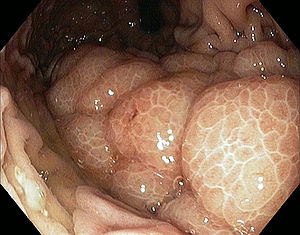Portal Hypertension
(Redirected from Portal hypertension)
The venous blood pressure 10 mm Hg and higher in portal vein is classified as portal hypertension (normal pressure in vena portae is 5–10 mm Hg). The portal hypertension (PH) is one of the most important liver cirrhosis complications. Is presented in more than 60% of patients with liver cirrhosis[1]. Its consequences are esophageal varices and splenomegaly.
Pathophysiology[edit | edit source]
The vascular ressistance in normal healthy liver (in liver sinusoids) is minimal. Then the normal pressure in portal vein is high enough to hold liver functional circulation. If the vascular ressistance gets higher, the pressure in portal vein must go higher to keep the circulation. Reasons of higher vascular ressistance can be:
- presinusoidal – typically portal vein trombosis;
- sinusoidal – liver parenchym diseases, especially liver cirrhosis, liver fibrosis (Wilsons disease, hemochromatosis);
- postsinusoidal – hepatic veins trombosis (Budd-Chiari syndrome) or inferior vena cava trombosis.
The sinusoidal ressistance is the most often.[1]
Pathological consequences[edit | edit source]
Splenomegaly[edit | edit source]
Splenomegaly in PH is caused by higher blood pressure in lienal vein. If the progress of PH is rapid, it can even cause intraabdominal bleeding (rupture of spleen), but it is quite infrequent.
Esophageal varices[edit | edit source]
There are junctions between portal vein and superior vena cava (portocaval anastomoses between gastric veins and esophageal veins). The esophageal veins are localized in esophageal submucosis. If the high blood pressure in portal vein expands here (the vascular ressistance is lower than in liver), the consequence are esophageal varices, which are dangerous because of possible bleeding. Esophageal varices bleeding is quite often complication in patients with liver cirrhosis (30–60% of them)[2].
Ascites[edit | edit source]
Ascites is accumulation of noninflammatory fluid in peritoneal cavity. Formation of ascites is based on natrium retention and vascular resistance in liver. The fluid with albumin gets from liver sinusoides to interstitial space in liver because of higher portal pressure. The liver lymphatic veins can drain away just a part of this fluid. The rest of this fluid gets out the liver to peritoneal cavity like ascites.[2]
Blood congestion in gut[edit | edit source]
Blood congestion in portal vein expands to vena lienalis and intestinal veins (via mesenterical vein). The consequence is mucosal hyperemia of small intestine, which can cause malabsorption.
Hypercirculation[edit | edit source]
Hypercirculation is caused by opened portocaval anastomoses. The vascular ressistance here is lower than the vascular resistance in liver. It causes, that these junctions are not only opend, but even the blood flow here can be pretty high. The portal blood (with substances obtained in small intestine) can "flow round the liver" to superior or inferior vena cava. The blood circulation is more rapid than it should be (it is hypercirculation).
Hepatic encephalopathy[edit | edit source]
Hepatic encephalopathy is multifactorial neuropsychiatric syndrome. It is probably caused by decreased liver metabolism (cirrhosis…) and hypercirculation (a part of the portal blood flows round the liver via portocaval anastomoses). Then the blood in system circulation contains higher level of toxins (from gut) and ammonia (produced by bacteries in gut).[2] This encephalopathy is characterized by disturbances in consciousness and behavior, personality changes and neurological symptomatology (flapping tremor)[1].
Diagnostic[edit | edit source]
- physical examination: caput medusae - dilated subcutaneous veins of abdomen, palmar erythema,
- USG: splenomegalia, hepatic venous pressure gradient (HVPG, normal is 3–4 mm Hg), ascites,
- gastroscopy: esophageal varices and their bleeding,
- lab: elevated liver markers (ALT, AST), koagulopathy (INR > 1,5), decrease of albumin,
- hematology: decrease in platelets (because of splenomegaly).
Therapy[edit | edit source]
Therapy includes therapy of PH itself and therapy of complication (esophageal varices and its bleeding, encephalopaty, ascites…), therapy of liver cirrhosis, liver transplantation.
Pharmacotherapy[edit | edit source]
Nonselective β-blockers with ISA like propranolol or nadolol - effects:
- vasoconstriction in splanchnic arterial circulation;
- vasoconstriction in portal venous system;
- decrease of cardiac output.[1]
Optimal heart rate decrease is 25% of heart rate or heart rate 55/min[2].
TIPS[edit | edit source]
Transjugular intrahepatic porosystemic shunt is arteficial junction between portal vein and inferior vena cava. This shunt is introduced via vena jugularis interna. This methode should be used in patients with complicated pharmacoresistant portal hypertension (often esophageal varices bleeding).[2]. This percutaneous methode replaced surgical shunt.
Links[edit | edit source]
Related articles[edit | edit source]
External links[edit | edit source]
References[edit | edit source]
- ↑ a b c d KASPER, Dennis L – FAUCI, Anthony S – LONGO, Dan L, et al. Harrison's principles of Internal Medicine. 16th edition. New York : McGraw-Hill Companies, Inc, 2005. 2607 pp. pp. 1892-1896. ISBN 0-07-139140-1.
- ↑ a b c d e ČEŠKA, Richard, et al. Interna. 1. edition. Prague : Triton, 2010. 855 pp. pp. 433-435. ISBN 978-80-7387-423-0.



